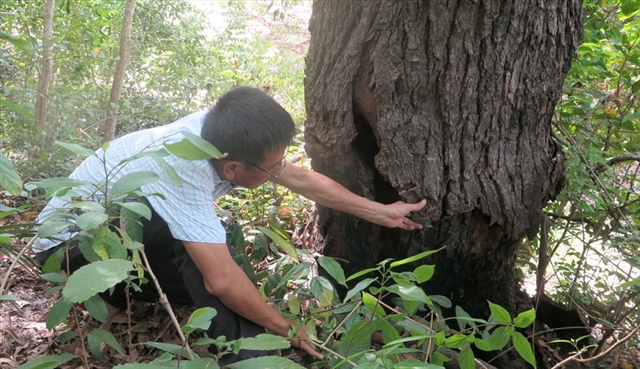 Society
Society


|
| Part of the trunk of Shorea falcata in Sông Cầu Town, Phú Yên Province has been rotten. — VNA/VNS Photo Xuân Triệu |
PHÚ YÊN — Phạm Văn Hòa is sixty years old, but he can still remember the first time he saw a chai lá cong (Shorea falcata) tree when he was a child.
He grew up in Hòa Phú village in the coastal central province of Phú Yên, where the chai lá cong can be found. His house is full of furniture made from chai lá cong timber.
"The wooden planks left from my grandfather and father are still very strong," Hòa said.
In this area, the tree has a spiritual significance to locals, he said, adding that in the coastal village they do not dare to cut down the tree. As a result, the trees could be still alive and bigger.
Some of the trees have been decayed and their bark has been eaten by termites, so they can be broken by hand, Hòa said.
Chai lá cong is endemic to Việt Nam. It is included in the International Union for Conservation of Nature (IUCN) Red List of Threatened Species 2012, meaning this variety needs to be strictly protected.
Statistics by scientists at the Institute of Natural Resources and Environment under Huế University show that there are only 13 trees left in Việt Nam, of which seven are in Sông Cầu Town and six others in the coastal area of Cam Ranh, Khánh Hòa Province. The trees grow at a very slow rate, so it takes a long time to replace those that have been lost.
Among almost 50 dipterocarp species, four species grow on coastal sandy soil and they play an important role in the rehabilitation of the forest ecosystems in sandy soil areas.
Chai lá cong is one of the four, along with dipterocarpus chartaceus, hopea cordata and shorea roxburghii. Hopea cordata and chai lá cong are very rare species.
Chai lá cong is a large-sized tree species of up to 20m in height and 1-metre diameter. Seeds have been collected and seedlings produced for planting in other areas for the conservation and development of plantations.
According to the director of the Institute of Natural Resources and Environment Hồ Đắc Thái Hoàng, the chai lá cong in Sông Cầu Town could be considered the "mother tree" because of it's age, which is hundreds of years old.
In the waters of Xuân Canh Commune, Sông Cầu Town, the chai lá cong has a diameter of more than one metre and is next to a rural road. The trees are about 30-40m high, spreading widely. Every year, the trees still flower and bear fruit, but the surrounding area does not have any seedlings.
Hoàng said that local people protect the trees in the way of the coastal people, considering them sacred.
"Many people don't know the tree is classified as an endemic and rare tree of Việt Nam," Hoàng said, adding that there were no signs to let people the trees need strict preservation.
Tôn Thất Thịnh, Director of the Sông Cầu Protection Forest Management Board said that it is necessary to have a long-term plan to conserve this precious tree species.
"The first thing is to investigate the distribution status and find the remaining regenerating species before conservation. The coniferous plant must be conserved genetic resources and propagated to be planted in areas with suitable site conditions."
"The conservation and development of the conifer tree have great significance in terms of economic value and environmental landscape," Thịnh said, suggesting Phú Yên Province develop and diversify the species in coastal protection forest areas. — VNS